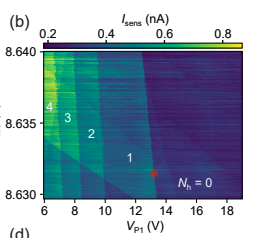Bilayer graphene (BLG) is emerging as a promising platform for semiconductor qubits in quantum computing due to its unique properties. Researchers from ETH Zurich and the National Institute for Materials Science in Japan have demonstrated the potential of a novel type of qubit, the Kramers qubit, encoded in the two-dimensional spin-valley subspace of BLG. This qubit exhibits robustness against known spin and valley-mixing mechanisms and has shown ultralong spin-valley relaxation times. These findings could lead to significant advancements in quantum computing, particularly in developing more stable and efficient quantum systems.
What is the Significance of Bilayer Graphene in Quantum Computing and Semiconductor Qubits?
Bilayer graphene (BLG) is a unique platform for emerging semiconducting qubits due to its intrinsic valley degree of freedom. The single-carrier quantum dot ground state in BLG exhibits a twofold degeneracy, where the two states have opposite spin and valley quantum numbers. By breaking the time-reversal symmetry of this ground state with an out-of-plane magnetic field, a novel type of qubit, Kramers qubit, encoded in the two-dimensional spin-valley subspace, becomes accessible.
The Kramers qubit is robust against known spin and valley-mixing mechanisms as it requires a simultaneous change of both quantum numbers. This potentially results in long relaxation and coherence times. The researchers measured the relaxation time of a single carrier in the excited states of a bilayer graphene quantum dot at small and zero magnetic fields. They demonstrated ultralong spin-valley relaxation times of the Kramers qubit exceeding 30 s, which is about two orders of magnitude longer than the spin relaxation time of 400 ms.
The demonstrated high-fidelity single-shot readout and long relaxation times are the foundation for novel long-lived semiconductor qubits. This research was conducted by a team of scientists from the Laboratory for Solid State Physics ETH Zurich, Research Center for Functional Materials National Institute for Materials Science, International Center for Materials Nanoarchitectonics, and Quantum Center ETH Zurich.
How Does Bilayer Graphene Compare to Other Materials in Hosting Qubits?
Low nuclear spin density is an essential property of a material to host highly coherent spin qubits. Another crucial criterion is the ability to fabricate high-quality quantum dots (QDs) with a known and tunable number of carriers. Bilayer graphene, which benefits from the low nuclear spin density of carbon, stands out as one of the few platforms that meet both requirements.
Recent studies have shown spin relaxation times (T1) of 50 ms for BLG, comparable to those of its main contenders such as silicon and germanium heterostructures. Additionally, intrinsic to the hexagonal graphene lattice, the twofold valley degeneracy provides an opportunity to define a qubit in the two-dimensional subspace spanned by the valley and the spin degrees of freedom. One obvious benefit of encoding a qubit using two quantum numbers instead of one is its robustness against different types of noise.
While the spin is coupled to surrounding magnetic moments and phonons via spin-orbit coupling (SOC) or hyperfine interaction, a valley flip requires a scattering process with a giant momentum swing on the order of the length of the reciprocal lattice vector, which is only known to be caused by short-range perturbations on the length scale of atomic defects. Given the high quality of encapsulated devices, the valley relaxation times were demonstrated to be at least an order of magnitude longer than spin relaxation times within a single device.
What Makes Bilayer Graphene a Unique Platform for Qubits?
BLG is not the only material with a valley degree of freedom, but in contrast to silicon, the energy of valley states in BLG is tunable by a perpendicular magnetic field. Additionally, valleys in silicon are oriented normal to the plane of the carrier gas, making them susceptible to spatial fluctuations in the interface potential, whereas the valleys in graphene are oriented in the plane, potentially leading to much less adverse effects of the BLG-hBN interface.
A large out-of-plane valley g-factor in BLG originates from the finite Berry curvature around the K-points and can be tuned using the electric field across a wide range of values. At zero magnetic field, the fourfold single-particle degeneracy is already lifted by Kane-Mele spin-orbit interaction. This interaction separates the energy of the two Kramers doublets by a spin-orbit gap, which has been previously measured to be significant.
By increasing the magnetic field, time-reversal symmetry is broken, resulting in an energy splitting of both Kramers pairs. The lower energy Kramers pair thereby forms a spin-valley Kramers qubit between K and K states. Previous studies showed coherent oscillations of a spin-valley qubit formed in a carbon nanotube (CNT), but yielded short relaxation times and decoherence times, similar to GaAs, despite the low nuclear spin density in carbon.
What are the Future Implications of this Research?
The research conducted by the team from ETH Zurich and the National Institute for Materials Science in Japan has demonstrated the potential of bilayer graphene as a platform for long-lived semiconductor qubits. The Kramers qubit, encoded in the two-dimensional spin-valley subspace, has shown robustness against known spin and valley-mixing mechanisms and has exhibited ultralong spin-valley relaxation times.
These findings lay the foundation for further exploration and development of novel semiconductor qubits. The high-fidelity single-shot readout and long relaxation times demonstrated in this study could potentially lead to significant advancements in quantum computing, particularly in the development of more stable and efficient quantum systems.
The research also highlights the importance of material selection in the fabrication of quantum dots and the hosting of spin qubits. The unique properties of bilayer graphene, such as its low nuclear spin density and the ability to tune the energy of valley states, make it a promising material for future quantum computing applications.
Publication details: “Ultra-long relaxation of a Kramers qubit formed in a bilayer graphene
quantum dot”
Publication Date: 2024-03-12
Authors: Artem O. Denisov, Veronika Reckova, Solenn Cances, Max J. Ruckriegel, et al.
Source: arXiv (Cornell University)
DOI: https://doi.org/10.48550/arxiv.2403.08143

